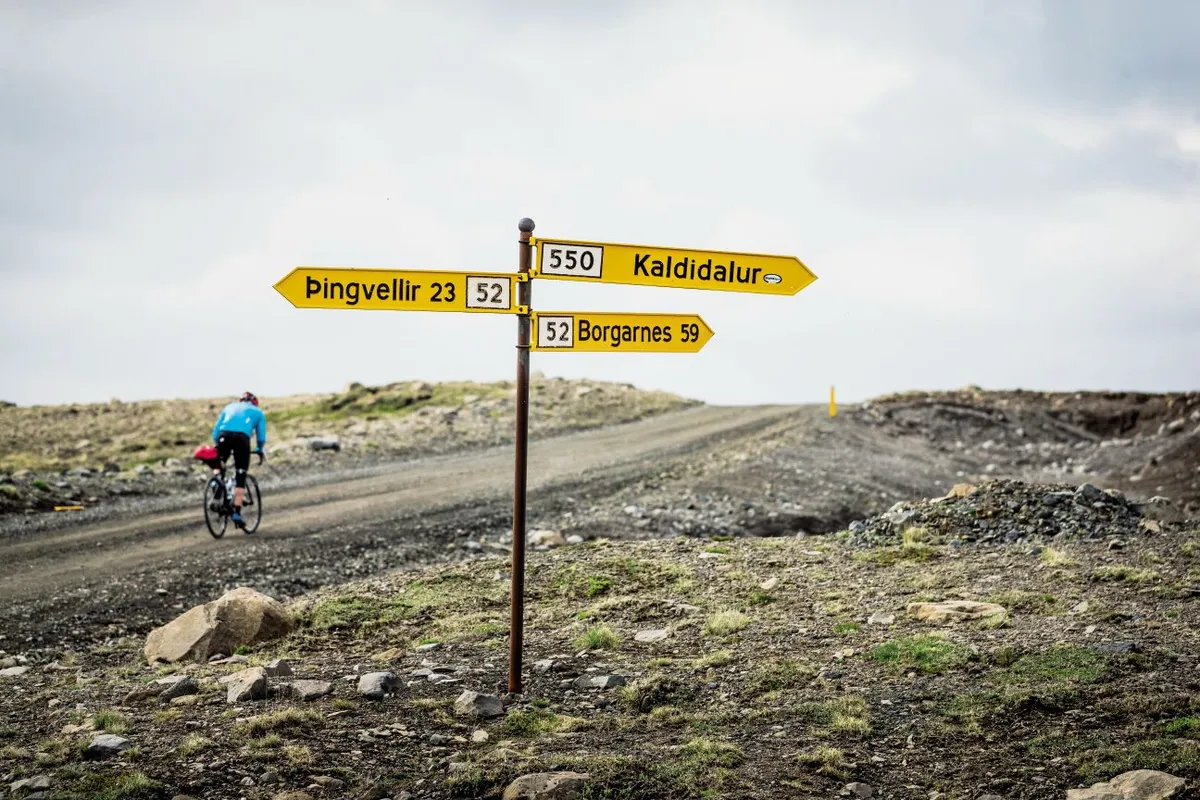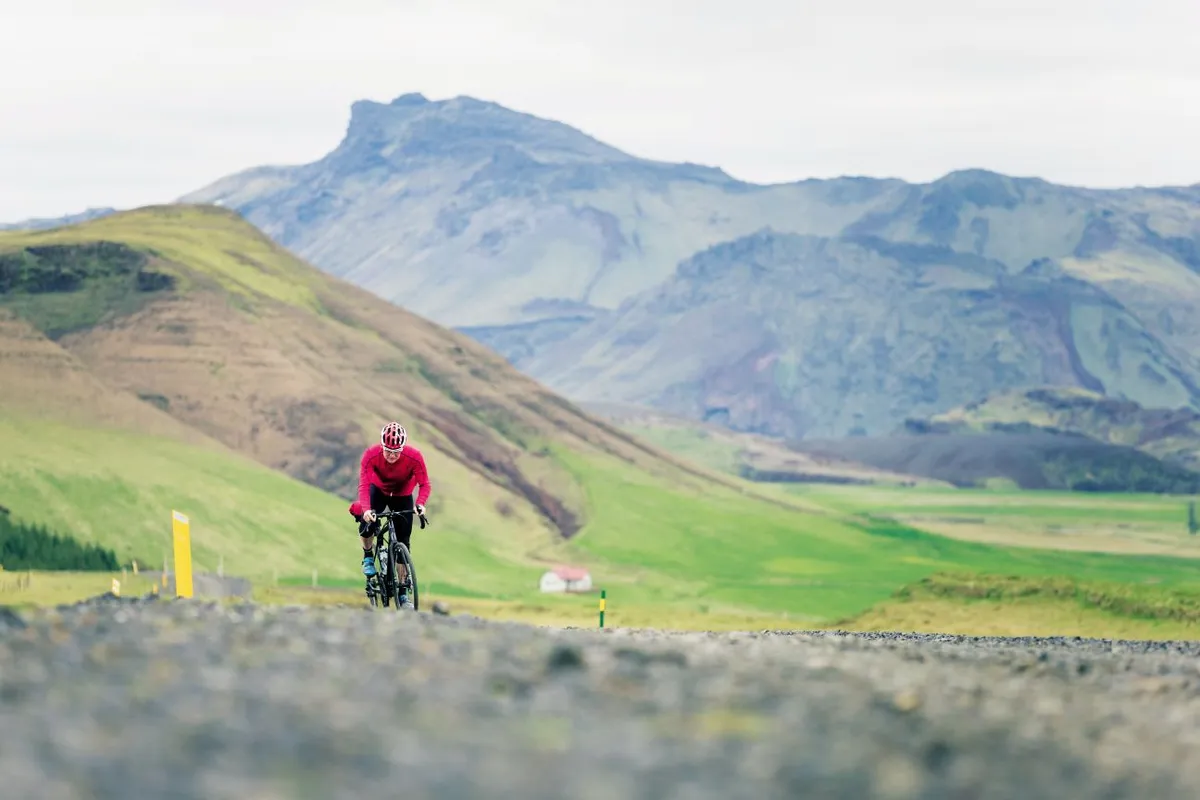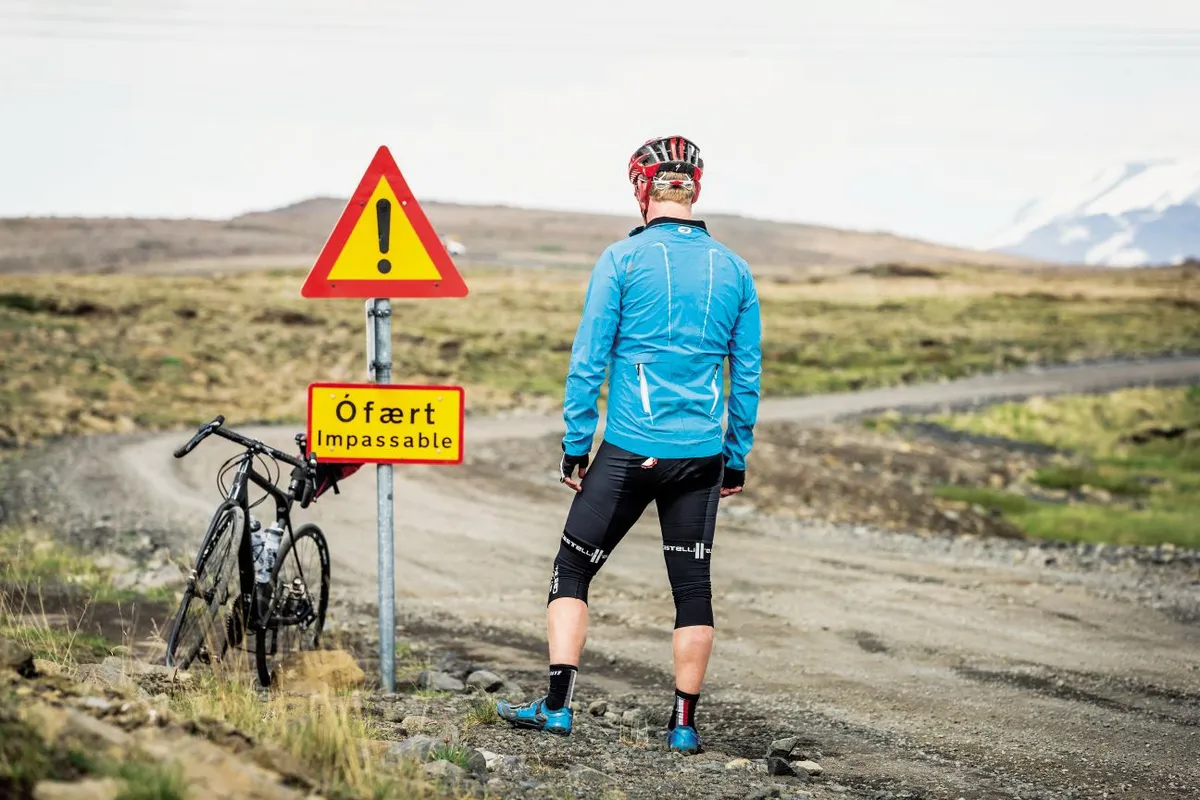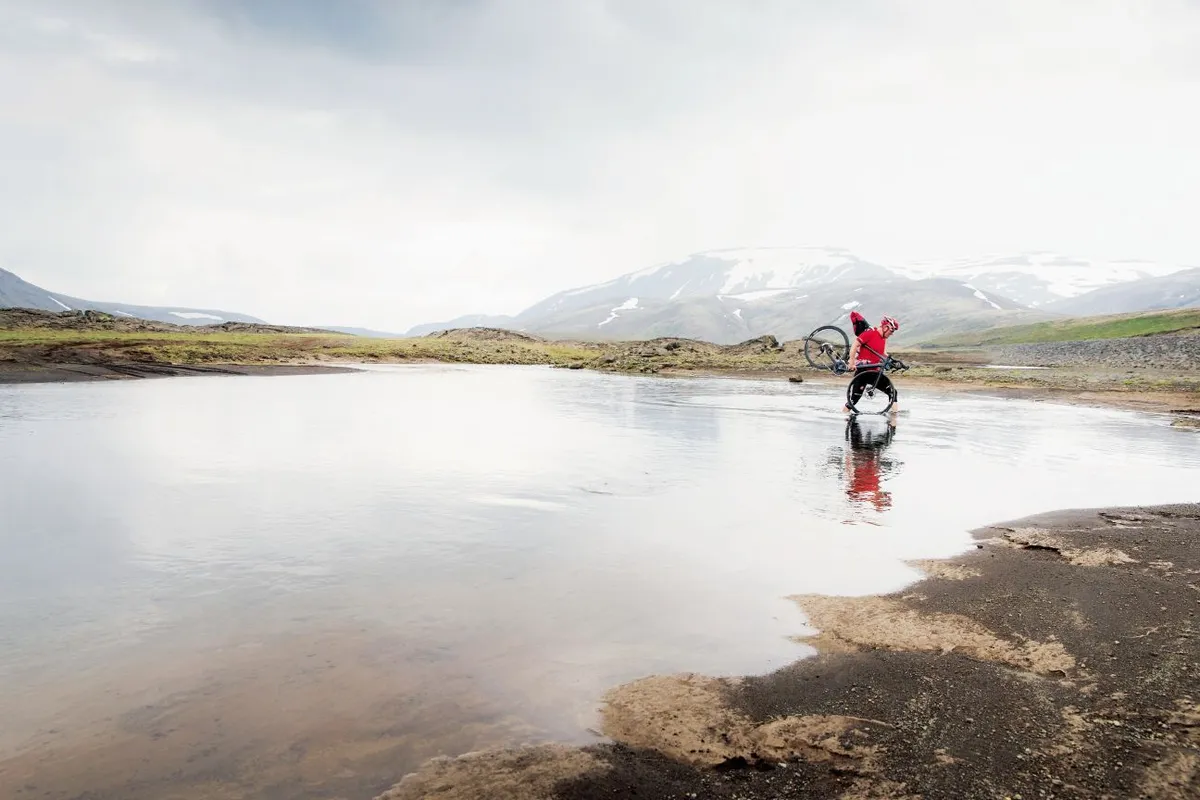Our photographer, Russell, hides behind a chunk of rock recently (in geological terms, at least) spewed from the neighbouring volcano. He’s waiting for my arrival as the gale force wind blows fine grit at him, his camera and me.
My ride is GT’s Grade, which it touts as a bike for riders who ‘rebel against what road riding should be and want a bike that knows no bounds’. Filter out the marketing speak, and what it really means is a road bike that’ll go anywhere, but isn’t a cyclo-cross, mountain or touring bike. I think.

So, this is how we find ourselves on top of an Icelandic plateau, battling winds, dust and some wholly unsuitable roads on which occasionally humongous 4x4s, with massive wheels and chunky tyres, roll by. There are no normal cars on this road, they all turned around at the last river crossing.
Off-road experience
Coming from a mountain biking background I’m used to crossing rugged terrain, but usually with tyres four times as wide with plenty of chunky tread, and often held in place by a minimum of 120mm of suspension. At least the Grade could match my regular ride’s disc brakes.
My previous experience of Icelandic cycling involved three weeks of constant rain followed by three weeks of intermittent rain, so I was prepared for the worst. Rolling out of the capital Reykjavik, I headed towards Thingvellir, an area that’s part of the North Atlantic rift system, one of only two places on earth (the other is East Africa’s Great Rift Valley), where the effects of two major tectonic plates drifting apart can be seen.

Thingvellir is firmly on the tourist map, and the main roads that lead to it are smooth and wide. Traffic is a constant companion, but given that the population of the country is roughly that of Bristol, I’m hardly choking on fumes. The traffic is light enough that I’m not being squeezed onto the verge as drivers jostle for valuable seconds.
The easy roads allow me to get used to the Grade. The flared handlebar is comfortable, the braking consistent and powerful, and the relaxed gearing means that while I’ll never slay any Strava KOMs, I’m enjoying the ride. I haven’t ridden with such wide tyres on a road bike either, and with the compliance from the frame, the 70psi I’ve got in there irons out much of the inevitable tarmac road buzz.
While Thingvellir is impressive, it’s crowded with tourists and, inexplicably, a brass band. Before long my interest has waned. I’ve seen it before, but not ventured up into the hills behind, and the temptation is strong. A smaller road peels off the main road just past Thingvellir and within metres the character changes. A lower grade tarmac gives a rougher ride, which doesn’t improve as I head higher. The road twists and turns as it scales the side of the plateau, not dissimilar to some of the climbs I’ve done in the Alps, but fortunately shorter.

I meet Russ halfway up for a quick photo. Here, the volcanic rock has proven just too rugged for the road-making machines; the inside of the corner is perforated by volcanic rock poking through the tarmac having defied the mechanical grinding of a road grader. As the road continues, so does its acne’d surface. When the road temporarily dips and speeds increase, they become harder to spot, but fortunately the easy riding nature of the Grade and its sturdy wheelset mean the occasional stutter over the top rarely raises concern.
Hit the dirt
Eventually the tarmac peters out, giving way to a single-tracked dirt road, just the type of thing this new breed of gravel bike is meant to be good on. Initially very little changes, the road was rough before, and still is after the transition to dirt, the only noticeable change is the sound of the tyres crunching on the fine grit and sand below.
Up until now the weather has been friendly – blue skies, gentle wind and warm temperatures – but the weather in Iceland has a nasty habit of lulling you into a false sense of security. As the road rises, so does the wind, and for brief spells sheets of rain pelt me. I’m travelling light, with just a saddle pack from Porcelain Rocket carrying the essentials for the next few days’ cycling, but my waterproof was pretty much top of my packing list. I’m glad to have it for both the rain and the wind, which whips body temperature away without mercy.

While the rain relents, the wind does not, especially as I approach the top of the plateau. Up here the road levels, meaning the going should be easier, but it coincides with the deterioration in road conditions. Gone is the well maintained dirt and in its place is a rutted, narrow, almost mud track.
I want to make a loop up here to save back tracking over the same ground, so take the decision to ignore the sign telling me the road is impassable. Surely this is just meant for cars, not the bike that can go anywhere and do anything? I’m not the only one ignoring the signs either, as I see a few cars coming towards me, and a couple of 4x4s pass by heading deeper into the hills.
I soon find out why the cars are heading back. A shallow river crosses the road a couple of kilometres later – it’s too deep for a car, but passable for a jeep. Russ has been equipped with a Landcruiser and I haven’t found him stranded yet. With no traffic coming for me to hitch a lift across with, off come my shoes and socks. I’d like to say I hotfooted across the river, but I’d be lying. It was freezing, the kind of cold that goes straight through to your bones and leaves you feeling nauseous. A tirade of abuse at the river left the air blue, much like my feet, which needed a vigorous massage before I got going again.
I found Russ, cowering behind his rock, the rain not managing to dampen the dust enough to keep it down. While waiting, Russ had chatted to other drivers who’d just spent an hour pulling a stricken car out of a snow bank. It looked like I was going to have to retrace my steps back down the hill and, more importantly, through the river.
Hot stuff
Iceland is blessed with abundant geothermal resources. Geothermal power plants dot the landscape around the separating plates, while hillsides occasionally emit plumes of sulphurous steam. The road to Geysir, Iceland’s most famous geyser, is smooth and fast, the wind that previously gave everything a fine coating of grit now pushes me along at a fair old pace and the kilometers pass by as fast as they might in a peloton. I’m missing the big gears of my road bike, but I can still hunker down into an aero position to minimise energy use.

Russ and I watch a few eruptions of Geysir, but despite the ridiculously long summer days, we’ve beds and food to get to. We press on, heading back towards the south coast.
Into the valleys
Wide, fertile valleys in the south of Iceland provide a lot of the homegrown food, supplemented by geothermal heated greenhouses, and it’s along these valleys I’m heading. The mountains behind have given way to green rolling hills, and as the coast approaches the rivers widen into broad braids of water, their multiple channels separated by dark grey volcanic gravel. Where these enter the North Atlantic, long black beaches are pounded by top-heavy waves, blown in by the winds. Cutting east along Route 1, side winds are a constant presence, at times aiding my progress, often hindering it. I pass more cyclists here, many struggling up rises weighed down by multiple panniers, bags, and no doubt, the odd kitchen sink. Fast and light may only get you so far, but it feels the way to go out here.

Farmers making the most of the fertile volcanic soil populate the south coast’s broad plains. Every 5-10km a small cluster of houses appears, cowering under tall cliffs, or standing proud in the wind that pounds them. White walls and red roofs are a common theme, while every now and again spires of small churches jut into the air. More often than not they’re serviced only by dirt roads, their washboard surface making for unpleasant riding. The extra space available means twists and turns are less of a requirement for road builders, so I’m faced with long stretches of straight road, which, while distance efficient, don’t make for the most inspiring riding. In the distance though, the cliffs of Vik are visible, tall landmarks that punctuate the skyline between the sea, plains and hills beyond.
Vik would barely register as a village in the UK yet it’s one of the main towns along the south coast. Russ spots a group of houses near Vik’s cliffs he wants to photograph, so these mark the end of the trip. Fittingly they’re strung out along a rough, gravelly road. The tyres supplied on the Grade have tackled everything I’ve thrown at them without a puncture. At times I’ve lacked grip, occasionally slipping out when climbing a grit strewn road, and I’ve often wished for a bit more cushioning from the jarring track surfaces, but I think the Grade has made its point. While a mountain bike may have been more suited at times, the Grade has stepped up to the mark, proving itself a capable machine able to cover the road less travelled.
Icelandic riding
Iceland might not have the road density that we enjoy here in the UK, but the variety of landscapes makes riding here an incredible experience. Weather conditions and road surfaces are far from guaranteed, so take a suitable bike, clothing and sense of adventure. Campsites are reasonably easy to find, while hotel and Airbnb accommodation is also available for those looking to pack light.
Images: Russell Burton
Full disclosure! This article originally appeared in Cycling Plus as part of an editorial partnership with GT.
Find out more about the latest issue HERE. You can subscribe to Cycling Plus here and check out our Facebook, Instagram and Twitter accounts for all of the latest road cycling action.
